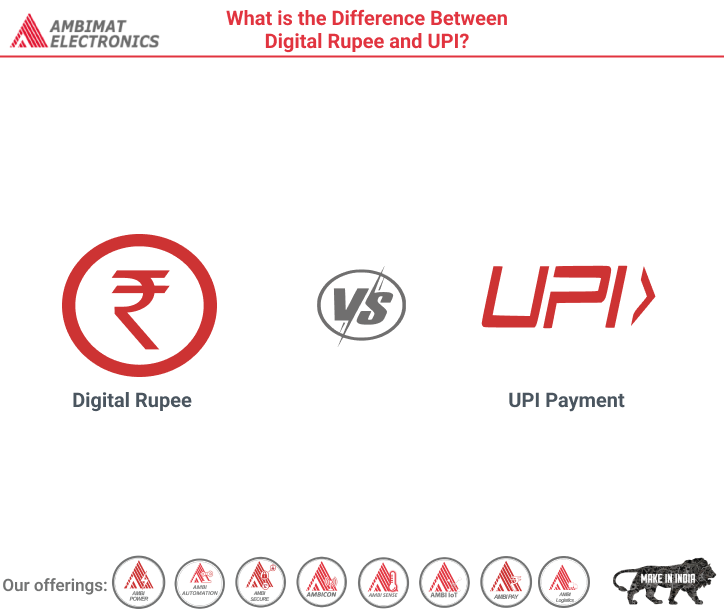Dear Readers,
In this blog, we will understand the topic of the Difference Between Digital Rupee and UPI
In the rapidly evolving landscape of digital payments, both Digital Rupee and UPI have emerged as crucial components of India’s financial ecosystem. It aspires to offer a reliable and effective means of exchange, facilitating smooth digital transactions. The breakthrough peer-to-peer payment system known as UPI, or Unified Payments Interface, enables immediate financial transfers between banks using mobile applications. It serves as a link between various banks, allowing customers to conduct real-time transactions without providing lengthy account information. Understanding the differences between Digital Rupee and UPI is essential to maximising their potential for moving India toward a cashless future as the country experiences a spike in digital transactions.
What is a Digital rupee?
Digital Rupee refers to the digital version of the Indian Rupee, the official currency of India. This government-backed program aims to digitally transform physical money so that it can be used and accessed online. The digital rupee is a digital representation of traditional currency’s value intended to make digital transactions straightforward and secure.
Centralisation and control
The Reserve Bank of India (RBI) is the central institution that issues and controls the digital rupee. Similar to how it oversees real currency, it runs on a centralised infrastructure, and the RBI controls its production and circulation. Although centralised control provides security and stability, it may also lead to privacy and monitoring issues.
What are the Uses of a Digital Rupee?
Cross-Border Transactions: The Digital Rupee can simplify cross-border trading for individuals and companies, removing the need for intermediaries.
Benefits to the government- It can help reduce leakages and ensure prompt delivery by directly transferring government grants and benefits to citizens’ digital wallets.
Black money reduction- Digital Rupee can reduce black money and improve economic transparency by encouraging digital transactions.
What is Unified Payments Interface – UPI ?
The National Payments Corporation of India (NPCI) created the groundbreaking Unified Payments Interface (UPI) payment system. Through their smartphones, consumers may immediately move money between bank accounts. UPI is a peer-to-peer and merchant payment system that supports real-time interbank transfers.
Decentralisation and control
UPI connects various banks and payment service providers without a central intermediary because it runs on a decentralised network. Although NPCI manages the system and establishes the rules, different banks and payment apps handle UPI transactions, giving users multiple options.
Peer-to-peer payments
UPI enables smooth financial transfers between people, making it simple for users to divide bills, send money to friends and family, and pay suppliers.
Merchant payments
UPI QR codes are widely used by companies as they make the receipt of digital payments from clients quicker and simpler.
Online Shopping
UPI can be used to make purchases online, speeding up the checkout process and removing the need to enter debit/credit card details.
Difference Between Digital Rupee and UPI
Nature
The Indian rupee is available in digital form as the “Digital Rupee,” which has the same value as actual money. On the other hand, the UPI payment system enables immediate money transfers between bank accounts.
Issue authority
The central authority, which is RBI, is responsible for issuing and regulating digital rupees. Contrarily, UPI was created by NPCI and is used a decentralised platform with several banks and payment service providers.
Scope of use
The Digital Rupee program aspires to digitalise all aspects of the monetary system, including international trade and government benefits. Peer-to-peer and merchant payments within the nation are UPI’s main areas of concentration.
Centralisation vs. decentralisation
While UPI runs on a decentralised platform and offers users flexibility and choice, Digital Rupee functions on a controlled infrastructure that ensures control and security.
Conclusion
Digital Rupee and UPI are two essential pillars supporting India’s digital payment revolution, each providing unique features and benefits. While UPI functions as a decentralised peer-to-peer payment interface that enables real-time transactions between banks, digital rupee acts as the digital counterpart of the national currency, issued and regulated by the central bank.
In contrast to UPI, which offers frictionless transfers through its effective, decentralised platform, Digital Rupee offers a centralised government-backed digital currency. These differences may be seen in the systems’ nature, scope, and transaction processes. Understanding the differences between Digital Rupee and UPI is crucial for maximising their potential and advancing the country toward a more inclusive, cashless future as India embraces the digital era.
About Ambimat Electronics:
With design experience of close to 4 decades of excellence, world-class talent, and innovative breakthroughs, Ambimat Electronics is a single-stop solution enabler to Leading PSUs, private sector companies, and start-ups to deliver design capabilities and develop manufacturing capabilities in various industries and markets. AmbiIoT design services have helped develop Smartwatches, Smart homes, Medicals, Robotics, Retail, Pubs and brewery, Security.
Ambimat Electronics has come a long way to become one of India’s leading IoT(Internet of things) product designers and manufacturers today. We present below some of our solutions that can be implemented and parameterized according to specific business needs. AmbiPay, AmbiPower, AmbiCon, AmbiSecure, AmbiSense, AmbiAutomation.
To know more about us or what Ambimat does, we invite you to follow us on LinkedIn or visit our website.
References:-
https://paytm.com/blog/digital-currency/what-is-the-difference-between-digital-rupee-and-upi/




